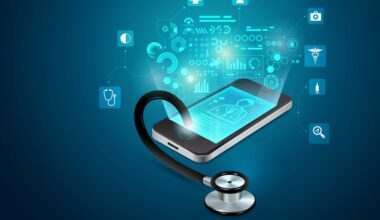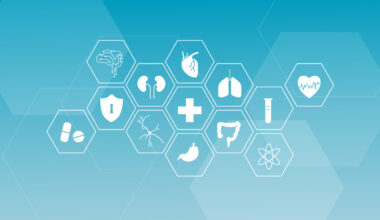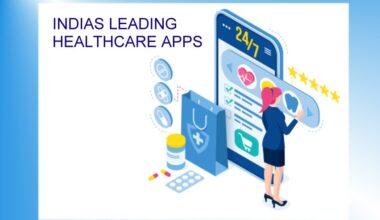
Do you know ‘Coronavirus’ topped the list of Google Searches, 2020? Yes, Google processes billions of searches every day, and not surprisingly, ‘Coronavirus’ turned out to be the most searched term on Google in the erstwhile 2020. Why? Because people cared for their life. When life becomes uncertain, people seek answers. This phase in humanity brings about a transition in the world of digital healthcare where telemedicine comes out to be a unanimous choice! Advancements in AI as a cutting edge technology, its applications in telemedicine happened years ago. However, with the onset of COVID-19, telemedicine is back in full swing. In layman’s language, it is a digital application that allows doctors to prescribe medications, treat patients through their screens.
Let’s see how AI transformative capabilities are helping the telemedicine industry the world over.
1. Digitization of Patient-Doctor Relationship
Artificial Intelligence (AI) in collaboration with Edge technology, has empowered the telemedicine industry to a greater level. With the help of AI, telemedicine is evolving patient care and healthcare experience through smooth accessibility. It helps in remote patient monitoring(RPM) or telemonitoring that gathers patients’ data from medical centers, hospitals, to keep a tab on their health conditions. Telemedicine has been a major factor in treating COVID-19 while curbing its speed at the same time. For instance, AI technology helping telemedicine for remote-patient monitoring, where doctors could track the current health status of high-risk patients, by using internet-connected at-home devices and mobile applications where two-way communication becomes feasible. This process minimizes the health risks for elderly patients or post-op patients or those suffering from chronic illness.AI enabled Telemedicine facilitates collecting data from varied connected devices and gives insights to doctors who then do adjustments in care and monitoring of compliances for severe patients like coronary patients. The latter need to maintain specific medication and lifestyle changes to make progress in their health respectively.
2. Enabling Doctors’ Collaboration
AI feeds on data and new AI applications come to the fore when more data pools come out of the telemedicine processes like remote-care, and so on. Moreover, AI-based telemedicine facilitates hospitals, healthcare institutions, and clinics, doctors to mutually collaborate in novel ways. This way, they manage to pool resources from each other at critical times. For example, Banner Health, one of the largest non-profit systems existing in the US, during the surge of COVID-19 patients, collaborated with Intel, as well as VeeMEd, a telehealth platform, and brought AI-powered telemedicine software solutions to more than one thousand in-room televisions throughout Banner-Health’s twenty-eight facilities in the country. This collaboration helped specialists (from pulmonology, infectious diseases, cardiology, critical care, nephrology) in the facilities to attend to more patients without risking COVID transmission. Another big help had been that these specialists did not need to spend on expensive personal protective equipment like masks, gloves, and face shields and could preserve them for emergency needs. All thanks to AI-powered telemedicine that allowed(and allowing) consulting with patients on a remote basis.
3. HIT or the Health Information Technology
AI-powered telemedicine facilitates the collecting, storing, and managing of massive electronic data in varied healthcare systems. This AI capability is called Health Information Technology(HIT) in telemedicine terminology. For instance, several electronic health records, e-prescriptions, etc. help patients and doctors to meet their mutual goals towards coping with diseases like diabetes, flu, viral diseases, etc. All these data are processed using HIT. How does it work? AI algorithms in HIT facilitate retrieving, systemizing medical data in various healthcare institutions, hospitals. Artificial Intelligence(AI) is helping in the segment of health information system in the following two ways-
- NLP helps physicians, doctors, to categorize records of patients, varied healthcare policies systematically.
- AI-based Neural Networks, are hugely applied for storing a wide scale of medical data. Also, it protects these data from fraudulence and unethical activities.
4. Tele Diagnosing of Patients
AI-powered tele-diagnosis of patients is a clinical method that incorporates a remote-based diagnosing of patients located across geographical boundaries. The telemedicine approach of this kind proves to be very effective in the early diagnosis of deadly diseases like cancer. Here, AI helps patients in early diagnosis of cancer, at its nascent stage itself when it is curable. Another area in telemedicine where AI is helping a lot is that of Tele-Dermatology. Like, detecting Melanoma, a severe type of skin cancer, is possible by AI-based Convolutional Neural Networks.
AI Lets Genie Out of the Bottle
AI technology is helping the telemedicine industry in varied ways, in varied virtual forms. Virtual Online Assistants, Natural Language Processing, and many more forms of AI are increasingly progressing in the market, bringing several novel ways of treating patients on a remote basis. There already exist some popular virtual online assistants, or the Chatbots like Babylon Health, OneRemission, Florence, and so on. As Steve Allen, the director of health solutions, Intel’s Health and Life Sciences group, says, “I think it’s fair to say that telemedicine helped stop the collapse of the health system here in the U.S. Now, it’s becoming recognized as valuable technology with real benefits to all parties.”
He continues, “the genie is out of the bottle.”
Interested to know more about AI in telemedicine and how you can leverage it in your business? Contact US.






